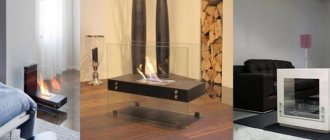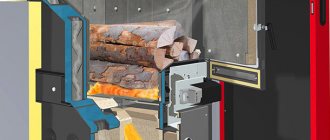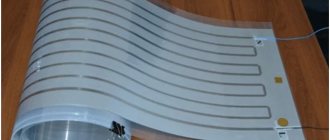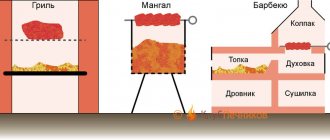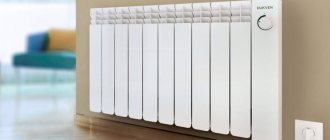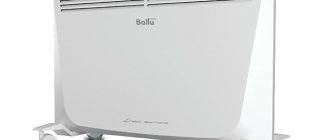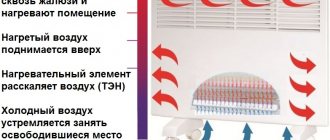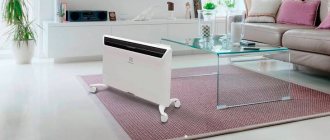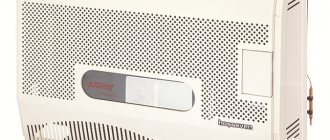The central heating capacity is not always sufficient to heat an apartment or house.
And there are also houses and premises where it is completely absent. Installing an electric boiler for a one-room apartment or two-room apartment is quite an expensive and troublesome task and requires constant monitoring and maintenance.
An old proven way out of this situation can be an ordinary heater. But what are they? What are their pros and cons, and what rules should you use to choose a heater for a bath, nursery, bedroom, office, etc.
Heater type
Today, the most popular types of heaters are:
- fan heaters
- models operating on the convection principle
- oil
- infrared
Each of them has its own advantages and disadvantages. Here's a summary table for comparison:
Although infrared received the most positive marks, there is no need to rush into making a choice. To choose the right model for yourself, use five rules.
How to choose for non-residential premises
For a non-residential premises such as a garage or workshop, the priority is to quickly warm up the air, and there is no need to maintain the set temperature for a long time. The best option in this case is a convector.
The budget choice would be a fan heater or a heat gun, which differ only in power. They will instantly warm up the room without spending a lot of resources, since they work for a short period of time.
Fan heaters are quite effective and economical, but they are not recommended for constant use in residential areas due to the noise they produce during operation.
There is no need to buy expensive and complex infrared heaters for such rooms.
On a note! An oil radiator is also a good option: it will quickly heat the room, and due to the long cooling of the oil, heat transfer will continue even after the device is turned off from the network.
Room area and device power
First of all, you need to decide what area you need to heat. The device of what power you need depends on this. How to calculate this power?
There is a simple and reliable formula that is suitable for all types of heaters except infrared.
For every square meter of a room with a standard ceiling height, it is advisable to have at least 100W of power.
For an infrared heater, there is an unspoken rule that 100W per 1m2 of area is its maximum power, not its minimum.
To the resulting value you need to add 200W for each window.
It follows from this that, for example, one room with an area of 13 m2 will be quite effectively heated by a model of 1.3 kW + 0.2 kW = 1.5 kW.
What if your ceiling height is 3m or more? Then use a slightly different calculation. Multiply the total area of the room by the actual ceiling height and divide this value by an average factor of 30. Next, also add 0.2 kW per window.
Of course, according to calculations, you can choose a less powerful device, especially for apartments where there is already main heating (central or boiler).
But given the constant heat loss and the fact that it will take longer to warm up the room, it’s better to play it safe. Devices with several heating stages are ideal. The more there are, the better.
Moreover, when the set temperature is reached, the built-in thermostat must turn off the device, no matter what level it is at. And when it decreases, turn it on again. Thereby significantly saving energy.
And also, a more powerful heater, when operated in “half” mode, will serve you much longer than its counterparts selected back to back.
And the area of the sections for heat distribution is higher - hence faster warming up.
Which heaters are the most economical and efficient?
The simplest and at the same time effective device for creating a comfortable microclimate in the house is an electric heater. It has a number of important advantages:
- ease of operation - to operate the device, just plug it into the mains. The device does not require any additional manipulations;
- the ability to customize the system, for example, select an operating mode, adjust the room heating temperature and even humidify the air;
- a variety of models allows you to choose the ideal option for you, which will cope not only with additional, but also with emergency or constant heating of the home;
- the device operates discreetly - without making loud sounds or emitting unpleasant odors;
One of the main advantages of electric heaters is ease of operation.
- To use such an electrical appliance, no special conditions or permits are required: an electrical network that can withstand the load is sufficient;
- models with high efficiency heat the room very quickly;
- It’s easy to choose a heater in any price category. Such equipment itself is not too expensive, and each manufacturer has lines of different classes. Thus, you can fit the purchase into almost any budget.
On a note! Remember that while the device itself is cheap, the heater consumes a lot of energy, and electricity is an expensive resource. Therefore, so that additional heating of the room does not hit your pocket, choose economical models of electric heaters.
Size and dimensions
It is quite logical to assume that the greater the power of the heater, the larger its overall dimensions will be.
However, note that in many models this only changes the width. But the height and thickness remain unchanged.
This is a very important point when placing heating on the wall and integrating it into other design elements.
At the same time, from leading manufacturers, even with the same power, you can always choose:
- low and very wide, for large windows or stained glass windows
- and vice versa - tall and narrow in small rooms
For example, two models with the same power of 2 kW, but what a difference in the width of the case. Which one do you think will heat better?
For designer interiors: electric fireplaces
Electric fireplaces are, first of all, home decoration, and only then heating. As the name suggests, they imitate a real wood-burning fireplace. An electric fireplace consists of a decorative imitation body with the effect of smoldering coals or live fire and, in fact, a built-in heater (usually convector).
The variety of electric fireplace designs is beyond description. There are built-in ones that are installed in the wall, and there are portable ones. There are luxurious portaloos, electric braziers, and even potbelly stoves. There are fireplaces that you can put real wood or coal into. As a rule, the more complex the design, the more expensive the fireplace is, but there are also generally nice, inexpensive models:
| Electric fireplace Electrolux EFP/M-5012 | |
Control system
In stores you can buy heaters with two types of control:
- mechanical
- electronic
Models with mechanical control are the simplest and cheapest. However, they have a whole bunch of shortcomings that not everyone is aware of.
- firstly limited functionality
- In addition, during long-term use they are more susceptible to wear. This means they will fail earlier than electronic ones.
- The error when setting the set temperature can reach several degrees!
- When turning on and off automatically they click quite loudly
And this happens constantly every 10-20 minutes. So you won’t want to leave such a unit in the bedroom overnight.
The electronic system opens up additional possibilities, including programming operating modes. They are also more accurate.
The temperature in expensive models can be set with an accuracy of a few tenths of a degree!
However, do not forget that electronic ones are often equipped with a backlight, which may not turn off completely.
And this can be quite irritating, especially if you are used to falling asleep in complete darkness.
There is a natural desire to cover such a screen with something. And here the most important thing is not to forget the basic safety rules for heaters:
- do not dry anything on them and do not cover the radiator openings
- Do not place near curtains or furniture
Therefore, check the lighting, as they say, without leaving the cash register.
Options for a country house
Choosing the most economical heater for a home located outside the city should be based on how often you visit there. When living in such a house all year round, the heater is connected to the local central or autonomous heating system. In this case, the principle of choosing a heater is the same as for a city apartment. It is also worth paying attention to inverter heaters, which can quickly warm up even a large house.
If you visit the dacha from time to time and there is no point in connecting to the central heating system, you need a device that will quickly warm up the room and can maintain a comfortable microclimate in it for a long time.
An oil radiator is suitable for use in the off-season, when the heating has not yet been turned on, but it has already become cold.
A convector or infrared heater warms up the room quickly and efficiently, but it is not practical to buy expensive equipment for a house where you rarely visit. If your dacha has some heat sources, such as a stove, you can choose the most budget-friendly option – a heat gun. If the house does not have heating at all, it would be optimal to use a combined heater.
Heating temperature
For an apartment, especially one in which there are small children, it is not recommended to buy heaters whose housings and elements themselves heat up to high temperatures.
For example, oil batteries without a thermostat (or if it suddenly breaks down) can heat up to 120-150 degrees!
It turns out that 2 kW are hidden in a small case, which can only be fully obtained by heating the heater to such temperatures.
At the same time, in order to comply with safety rules and not overheat the surface above 60-70 degrees, temperature sensors are installed. And they, in turn, turn off the heater, which actually never reached its maximum parameters.
And what can we say about the open hot spiral of the fan heater!
Therefore, in this regard, convectors can be considered the safest. When they are ceramic, the body temperature does not exceed 60 degrees. It’s not for nothing that many of them have signs “For kindergartens.”
Among infrared models, micathermic ones stand out in terms of safety.
The heating element in them emits heat, but does not heat up itself.
But for quartz, carbon and halogen filaments, the filaments heat up from 2000 degrees and above, after which infrared radiation actually begins to be produced.
Varieties and selection criteria
With the onset of cold weather, ensuring a comfortable temperature in the house or country house comes to the fore. At the same time, it is important not to go broke on the cost of heating the room. Therefore, it is important to use an economical electric heater: it can effectively warm up a room and save energy resources. Let's figure out how different types of such equipment differ and which heaters are the most economical. Heaters for the home: which one is better to choose (read more)
A properly selected electric heater can significantly save your family budget.
Reviews
Once you have decided on the type of heater, all you have to do is choose a specific brand and manufacturer. And then most immediately open online store sites with reviews.
Oddly enough, you can find completely opposite opinions on the same models on different sites. It is no secret that often the stores themselves or the moderators of the Internet portal can write certain paid comments and supposedly expert opinions.
Who to believe? Here the advice can be simple.
Try to focus on the reviews that people leave with real photographs of heaters at home in their apartment.
This way, most of the useless advertising information will be eliminated.
Let's take a closer look at the operating principle and each type of heater separately. To view, click on the corresponding tab with the name.
ConvectorInfraredOil Fan Heater
Which one to choose: principles of device operation
According to the type of operation, electric heaters are divided into several types:
| Principle of operation | Types of heaters |
| Convective | Electric convectors, heaters, fan heaters |
| Radiating | Infrared panels, heat-emitting mirrors |
| Combined (convective-radiative) | Oil radiators |
What are the features of these types of economical home heaters? Let's take a closer look.
Convector
The operating principle of the convector is based on a simple law of physics. Cold air naturally enters the device from below. After this, heating occurs inside the housing and, already heated, it exits through the upper grilles (at an angle) into the ceiling.
The case itself does not heat up as much as in radiator models. It is the air that heats up.
The truth is that the room does not warm up immediately. Unless there is an additional fan built inside. If you come home from work to a cold apartment and turn on the convector, then the floor of the house will be cold for a very long time.
Moreover, at a small height from the floor there will also be a layer of cold air. The warmest place in this case is the ceiling. If there is even a small draft, it will be quite difficult to warm up the walls and furniture in the room.
Almost all convectors are wall-mounted, but some are also equipped with legs.
Remember the rule that the lower the convector is installed, the more efficiently it will work out its kilowatts.
The wall-mounted installation option looks very aesthetically pleasing, but moving it from the bedroom to the living room or kitchen will no longer work.
The main heating element of a convector is a spiral. Therefore, such devices also burn oxygen.
But recently, heaters with a tube consisting of a large number of fins have increasingly begun to be used.
Thanks to this, even during prolonged operation, their body does not heat up more than 90 C. And for many models, the temperature is even less than +55-60 degrees.
Such options will be a good solution for families with small children.
When installing heating in a bathroom, make sure that the model has a minimum degree of protection IP24.
What do these numbers mean?
The first digit indicates that the device is protected from the penetration of solid objects larger than 12 mm into it. For example, the fingers of an adult.
The second number (4) indicates that the heater is protected from splashing water from any direction.
How much it will actually cost you to heat your home with convectors as the main source of heat can be found out from this video:
Which one should you prefer for an apartment or a country house?
As a rule, city apartments have central heating, so the device will not be used constantly. The heater is turned on in the event of a failure of the central networks, to instantly raise the temperature in the room, as well as in the off-season.
The most economical electric heater for an apartment will be a convector. It consumes electricity moderately, does not require large investments when purchasing, and is capable of operating for a long time. It is worth refusing to buy a fan heater: this type of equipment makes noise during operation, and is the most energy-consuming type of heater.
If the central heating system operates with frequent interruptions, you should pay attention to infrared devices, which are often equipped with thermostats. Therefore, if you buy an electric heater with an electronic thermostat, this will significantly save energy resources, and therefore the family budget. Basically, such a heater requires more electricity, but fine tuning and various operating modes make it possible not to turn on the equipment at full power, while at the same time maintaining a comfortable temperature in the room.
Fine-tuning the infrared heater and various operating modes allow you to use the device as efficiently as possible, while at the same time saving energy resources.
Infrared heaters
Most people are still wary of infrared models. Their operating principle is somewhat similar to the sun.
The infrared radiation of the lamps does not heat the air in the room, but the objects located in it, which then give off heat to the surrounding space. Heating occurs due to invisible rays in the infrared spectrum.
You need to get used to this. The feeling under the heater itself will be as if you were sitting near a stove. One side is fried and the other is at room temperature.
To protect yourself from the effects of such equipment, follow basic rules of use.
If you stay under such a heater for a very long time, you may feel a headache and fatigue.
However, the same thing happens from prolonged exposure to the sun or when sitting for a long time near an open fire.
In addition, the infrared spectrum in excess quantities can negatively affect the skin. Such a beam is capable of penetrating to a depth of several centimeters under the skin and only then releasing heat from the inside, heading to the outer surface of the skin.
Everything here depends on the power of the source and the duration of stay under it. If you follow the instructions, then you should not be afraid of such radiation. How to protect yourself?
The most important thing is to maintain a minimum distance from the infrared heater. It must be at least 2 meters.
The advantages of infrared technology include:
- instant warmth
- almost complete absence of oxygen loss
- no odor
- noiselessness
And as numerous tests show, such heating is the most fireproof. Even if you place a Christmas tree directly under an infrared heater (right up to its touching the protective screen), setting it on fire will be problematic.
Just don’t try to purposefully repeat such experiments at home. Heater is different from heater, and compliance with safety regulations should come first.
The device is lightweight. It can be equally successfully placed on the walls or ceiling (hung on mounting chains like a fluorescent lamp).
So fix it on special legs.
However, there are also some peculiarities. One of the disadvantages is that the efficiency of the device is limited by the dispersion angle.
Step outside this zone and you will immediately feel a temperature difference of several degrees. From the very beginning, IR heaters were created specifically for heating only work areas in rooms without heating.
To improve the heating efficiency when suspended from the ceiling, you can paint the floors a dark color.
There are also models made from ceramic plates, which also emit infrared thermal radiation, plus they look beautiful.
They have low power and are resistant to moisture. Therefore, they can be safely used in the bathroom.
Similar models of infrared heaters can be installed in children's rooms, on balconies and even outside in gazebos.
Popular types of household heaters
The market for heating units is vast, and it is difficult for a person ignorant of the intricacies of the characteristics of heat-generating devices to make a choice in favor of any specific model.
Which heater is best suited for a private home, and which one will be most functional in an apartment? To do this, it is worth studying in detail all the pros and cons of heating units.
Type #1 - oil devices
This type of heater is popular due to its ease of maintenance and high heat output.
To obtain heat, simply move it to the area of the desired high temperature concentration and plug the device into a power outlet.
The latest models of oil heaters are equipped with thermostats, which allows you to set a specific warm-up temperature. There are modifications with timers
The main structural components of the oil device:
- Metal tank. It contains a coolant - mineral oil, which can “hold” and distribute heat for a long time.
- A heating element. It heats up the oil, which redistributes the heat to the body of the unit, and from there to the surrounding space.
- Thermostat. Located on the control panel, it is designed to regulate the temperature.
The device looks like an ordinary radiator with an outlet to the electrical network. There are many models equipped with rollers, which ensures mobility and versatility of use.
The design of the oil device has an air cushion that compensates for the linear expansion of the oil when heated. Without it, the radiator would burst after short use
Significant advantages of a heater with coolant oil:
- Optimal power range. The interval is from 1 to 1.5 kW, which allows it to be used for heating not only an apartment, but also a country house.
- Automatic thermostat . Allows you to maintain optimal temperature conditions in the room.
- Maintaining comfortable air humidity. The device does not dry out the air, since it does not contain open heating elements.
- Price. The oil unit is inexpensive.
- Quiet operation. Does not cause discomfort to residents.
- Mobility. The wheels of the device make it easy to move.
Some models are equipped with a shutdown timer to save electricity.
We cannot ignore the negative qualities that reduce consumer interest in oil units. The heating process is slow and the distribution of warm air takes a long time. If oil leaks, burns and irritation may occur.
Are you interested in an oil type heater? We have an article on our website with recommendations for choosing it - follow the link to read the material.
Type #2 - modern convectors
The appearance of a convector heater differs from an oil radiator due to its more streamlined shape and compactness. It can be easily placed on the floor or wall. There are also convectors on wheels.
The convector device heats the air, which, when heated, rushes to the ceiling. Instead, the unit processes the next portion of cold air, which will then be replaced by an air mass cooled near the ceiling
Operating principle of an electric convector:
- Heating elements built into the central panel heat the air mass.
- The heated air flow, according to the laws of physics, rushes to the ceiling, freeing up space for the cold air.
- The air cooled under the ceiling moves back to the convector installation area, replacing the air mass heated by the unit.
The device is equipped with a sensor that takes readings about the actual air temperature in the room. It is worth knowing that the heater is safe with respect to the possibility of electric shock, since the heating element does not come into contact with the body of the unit and therefore does not require grounding.
This device can be safely used to heat children's rooms. It does not dry out the air and therefore does not promote the growth of harmful bacteria that prefer a dry environment
The undeniable advantages of convector heaters:
- Silence. The heating unit can operate almost continuously without causing irritation.
- Safety . Structurally minimized, the risks of fire and accidental burns are practically eliminated.
- Balanced heating. The unit evenly supplies air flows to the room being treated, which are regularly replaced by cooled mass.
The disadvantages include the low rate of heating of the rooms, which is more than compensated by the ability to maintain the temperature background due to the presence of a thermostat. The devices do not require thorough control, because the same device turns off and turns on the heater when the set temperatures are reached.
Convector heating devices are produced in two installation variations: wall-mounted and floor-mounted. The wall-mounted variety has more admirers as it is the most convenient and does not impede movement.
A built-in floor convector is an interesting solution that allows you to use space wisely. It is a system of heaters located in a metal casing
A rational place for the location of a convector device is considered to be the area under the window opening. In this position, it will not only process the air in the room, but also form a kind of air curtain that will prevent the penetration of cold currents from the street.
Don't know which convector is best for your space? We recommend that you familiarize yourself with the recommendations for choosing a convector heater for your home.
Type #3 - fan heater
A fan heater is essentially an improved convector. Its system uses thinner heating elements, and the air flow is stimulated by its own fan. The unit is attractive due to its small dimensions and similar weight; its installation and operation do not require special skills.
Fan heaters are equipped with different types of heating elements, including:
- Nichrome wire spiral. It is wound onto a rod made of non-flammable material, most often ceramic or graphite. May be open or enclosed in a glass flask. An inexpensive option, but often spreading the smell of burnt dust that settled on it during operation.
- Ceramic plate. It has a larger area than a spiral, so it heats up faster. The plate has holes through which heated air flows. It costs almost three times more than the previously described option.
- Metal or graphite heating element. This type of heater is placed in a tube with sand or manganese oxide filling the remaining space. This design allows for more even distribution of heat. It has more power than previous types, and is disappointing at its impressive price.
In addition to the listed heating elements, there are all kinds of variations on the theme of heating devices and devices. The operating principle of all types of units is simple: the device sucks air from the room, passes it through a thermal element and supplies it back.
You can even assemble the fan heater yourself, using available materials. We discussed in detail how to do this in our other article.
The fan heater is also called the “fastest” heater of all existing ones. If you need to warm up in an emergency, turn on the fan heater
List of advantages of fan heaters:
- Speed. The fastest possible heating of the air, thanks to the intensive circulation of the flow.
- Versatility. Can be used as a heater in winter and as a fan in summer.
- System protection. The thermostat prevents the device from overheating.
- Wide choose. Large selection of models - mobile, stationary, etc.
- High efficiency (85%). High performance reduces energy costs.
Among the disadvantages we include the fact of unwanted air drying. The units make noise when operating, sometimes burn dust and emit a negative odor. The latest models are protected from dust settling on the working part and from moisture entering the system.
Most fan heaters are small, portable models used as a source of additional heat.
A fan heater can serve as an additional source of heat in the presence of main heating, since its range of action is limited. The main thing is to choose the right device. In order not to be mistaken in this matter, we advise you to familiarize yourself with the material on choosing a fan heater.
Type #4 - thermal curtains
Such devices are most often used to complement utility systems at commercial and industrial facilities - factory workshops, supermarkets, shopping centers.
But in private homes, thermal curtains are also sometimes installed to create a barrier to cold air and retain heat indoors. The devices create a flow of warm air from top to bottom. Such a unit is capable of heating a small room (25 m²).
The systems operate on a principle common to all heaters. The device housing contains a heating element and a high-power fan. A powerful fan directs the air flow in a specific direction, and the heating element heats it.
In addition to standard heating work, the units create an air barrier for drafts.
Thermal curtains are used mainly as additional heat-generating elements. They would be appropriate above the front door of a country house.
Advantages of the devices:
- Economical. Contributes to heat conservation, because creating a barrier to the penetration of air from the outside, at the same time preventing its leakage to the outside.
- Excellent protection . Does not allow street dust, harmful exhausts and insects into the room. Isolates the space from cold air currents.
Disadvantages include high cost and increased energy consumption. They are capable of heating only a small room and are mainly used in combination with other heating equipment.
Automatic regulation of thermal curtains allows you to control their operation without much effort, simply by setting the desired setting, focusing on the size of the opening and the outside temperature
Type #5 - classic electric fireplaces
This device is very often used as an element of the interior, focusing more on its aesthetics than on its functional qualities. However, electric fireplaces are capable of efficiently heating a room. There are many types of this climate control equipment: island, corner, built-in, suspended, mobile.
Structural elements of electric fireplaces:
- Heating system. Heating coils or heating elements are located on the top of the panel.
- Air supply device. The built-in ventilation system supplies air to the heating elements and then into the room, simultaneously cooling the housing and preventing overheating.
The thermostat controls the operation of the fireplace automatically, responding to changes in the temperature background. The devices can also perform a decorative function - simulating fire with lighting.
Some modern electric fireplaces have backlighting, a sleep timer, a decorative fire burning speed control, and even a sound control.
Positive aspects of an electric fireplace:
- Simplicity. Does not require special installation, unlike a wood-burning fireplace. Does not require labor-intensive maintenance or cleaning from carbon deposits.
- Aesthetics. Creates a special atmosphere in the room. Thanks to the variety of models, it easily fits into urban and country interiors.
Electric fireplaces do not require a separate room and do not emit combustion products, for the removal of which it is necessary to install a chimney.
An electric fireplace is capable of heating a room as the main heat source in accordance with its power ratings.
The disadvantage lies in the high power consumption, amounting to 2-2.5 W per hour in active mode. It is mandatory to install modern wiring - old wiring may not withstand the voltage and cause a fire. The fireplace dries the air and “burns” oxygen.
If you still want to get a fireplace, and the electric option is not suitable for you, we recommend that you pay attention to biofuel fireplaces.
Type #6 - infrared heater
Infrared options are considered a new generation of technology and differ from fireplaces and oil radiators by a different operating principle. Their action is aimed at objects in the room.
IR heating devices do not heat the air mass, but objects that transfer it to the surrounding space.
Image gallery
Photo from
Direction of action of infrared heaters
Using IR heating devices outdoors
Safety of IR Heating Devices
Energy-saving advantages of IR heaters
Devices are produced in the form of traditional heaters, ceiling panels, film systems for installation under floor coverings or wall decoration. A detailed analysis of the models and tips for choosing IR heaters are given here.
They can be used as the main source of heat and as an auxiliary one. Artificial infrared radiation is the closest in spectrum to natural light.
However, it should not be taken as a natural source of heat. In itself, it is not harmful, but if you stay under a ceiling heater for a long time, for example, you can get a heat stroke identical to that of the sun.
The radiation of infrared heaters can be zoned. They are suitable for installation in open areas and can be used in greenhouses and winter gardens
Advantages of infrared heaters:
- Long-term work. There are no parts in IR heaters that can periodically burn out or gradually wear out. Elements damaged mechanically can be easily replaced.
- Economical installation. Or installation related to film systems. All construction and installation work is carried out without problems at an operational pace.
- Fast heating. Infrared heaters are not characterized by inertia; they quickly warm up areas and rooms.
- Possibility of zone heating. The activity of devices can be focused on a specific area or group of objects.
- Ability to work in open areas. They can be used to heat open spaces: terraces, sports fields, etc.
- Silence. Appliances and film heating systems operate without making sounds.
- Preservation of air humidity. IR equipment does not heat up and, as a result, does not dry the air. Its operation does not worsen the indoor microclimate.
The list of disadvantages includes energy dependence. This means that if used as the main heat source, it is necessary to consider a backup power supply device.
Not everyone is satisfied with the backlight of the control panel, which operates continuously while the heaters are operating. To protect against energy surges and current leaks, you will have to purchase expensive automation.
Installing an infrared heater on the ceiling eliminates the need for heated floors
This device is suitable for heating log houses, as it warms up wooden walls well and does not require design documentation for installation. In addition, energy savings are significant, compared to other electric heaters - 6-7 times.
One of the varieties of infrared heating devices is a carbon heater equipped with an element of the same name. We recommend that you look at our other article with a detailed overview of the types of infrared carbon heaters and recommendations for selection.
A carbon heater, by analogy with all types of infrared, works on the principle of long-wave radiation - it heats bodies and objects, not air
Type #7 - monolithic quartz heaters
According to the principle of operation, the quartz monolithic group belongs to convector type heaters. The device is simple: it is a panel made of a molten mixture of quartz sand with a small amount of marble chips.
Inside the panel there is a spiral-shaped heating element that can heat up to 120 °C. The spiral transfers thermal energy to the inert quartz body, as a result the device heats up only to 95 °C.
The quartz case works on the principle of wood - it retains accumulated heat for a long time. The use of this category of devices will help you save money, because... units do not have to work constantly.
The body of a monolithic quartz heater accumulates heat and then gradually releases it to the cooled air
Advantages of heaters with a monolithic quartz body:
- Economical energy consumption. Cost reduction is achieved due to the ability of the housing to accumulate and slowly release heat.
- Easy to install. The installation will be completed by an inexperienced person acting in accordance with the instructions supplied by the manufacturer.
- Does not dry out the air. The heater enclosed in a monolithic housing does not affect the microclimate. For the same reason, it does not burn dust and does not emit unpleasant odors.
- Suitable for wet rooms. The sealed housing protects the spiral from contact with splashes and damp environments.
- Safety. The body never heats up to critical temperatures that promote fire and cause burns.
Monolithic modifications are equipped with thermostats that control the operation of devices. When leaving, for example, from the dacha at the end of the season, the units can be set to a minimum temperature of + 95 °C.
The cost of the devices is low, but their weight is quite impressive. Also, not everyone likes the appearance of the heater, but the ability to install special replacement panels of any color eliminates this problem. This type of heater is the best option for heating an apartment or private house.
We invite you to look at a detailed guide to choosing a quartz heater for your home and garden.
Type #8 - halogen devices
The difference between halogen heaters and infrared heaters is a special heating element. It consists of a tube filled with an inert gas with a tungsten filament inside. The gas prevents the destruction of the tungsten filament, chemical reactions within the tube are excluded.
Otherwise, the operating principle of halogen devices is similar to the operation of infrared heaters.
Pros of halogen lamps:
- Saving. Reduced energy consumption compared to electric fireplaces or oil radiators.
- Mobility. Floor heaters can be installed in different places that require increased heating.
- Fast heating. Provided with design features of the working element of the unit.
Most models have rotating mechanisms that allow you to direct the heat flow in the required direction.
Halogen heaters are equipped with control systems and devices that turn off the device in the event of a fall or overheating
Disadvantages include the light supplied by the device being too bright. It is harsh and unpleasant, especially at night. the second disadvantage is that the tube is too fragile, which will have to be changed periodically.
Many also noted that it is difficult to heat the entire room with halogen lamps and achieve the desired temperature in it. The heater heats only within the limits of direct action.
Type #9 - micathermic heaters
Despite the relatively small size, the micathermic type of devices is pleased with its high efficiency. This new product on the market of heat-generating units has already made a worthy statement, but consumers are still wary of it.
They do not dry out the air during a fairly fast and efficient heating process.
Image gallery
Photo from
Operating principle of a micathermic heater
Advantages of economical operation of devices
Mobile model of a heating device
Micathermic options
The heating element, created using Micatherm technology, is a kind of sandwich assembled from two layers of mica with a nickel mesh between them.
Heating is carried out by the mesh, and mica is responsible for temperature balance and mechanical strength. The devices combine the heating principles of convectors and infrared systems.
Convincing advantages of micathermic heating devices:
- Reduced energy consumption. Electricity consumption is 25% less compared to conventional heaters.
- Maintains humidity levels. An additional plus is that the units do not burn oxygen like many types of electrical appliances.
- Safety. The risk of burns and fires is structurally excluded.
It is not recommended to dry laundry on a micathermic heater; if necessary, cover it with a cloth. This may cause the unit to break down.
The design and low weight of the micathermic element allows it to quickly heat up and quickly reach operating temperature
However, the device is not suitable for the role of the only heat source in a living room, but will be a good addition for emergency heating of a certain area.
Are you still undecided whether this type of heater is right for you? We advise you to familiarize yourself with a detailed analysis of the pros and cons, as well as the features of choosing a micathermic heater.
Type #10 - heat guns
When wondering how to choose the best heater for an apartment or private home, many people pay attention to heat guns. Such a unit will perfectly cope with the role of the only source of heat in a country house.
The devices are arranged without any special fuss. A fan inside the housing supplies air to the heating element, distributing the flow into the room. The thermostat regulates the operation of the device, preventing it from overheating.
What are the advantages of using a heat gun:
- Mobility. The device can be easily moved from place to place.
- Speed and efficiency of work. The unit is able to quickly heat a large area. It is used for heating large areas; in construction it is used as equipment that provides conditions for drying monolithic structures and for work.
- Performance. Can serve as the only source of heat if there is no alternative.
Before using a heat gun, you need to make sure that the electrical wiring can withstand such a load. Houses with old wiring are not suitable for heating with such an element due to the high probability of fire.
Heat guns are universal: suitable for heating large areas, used during construction for drying monolithic structures or finishing
True, a heat gun consumes a lot of energy. Most models are connected to a three-phase industrial network. When using such powerful equipment, it will be necessary to install protective automation.
Modernization of heating devices brings to the attention of consumers new items that are used for their intended purpose and also serve as unusual decor in the interior.
Have you decided to purchase this type of heater? We recommend that you familiarize yourself with the criteria for choosing a heat gun.
Oil heater
The operating principle of an oil heater is somewhat similar to a conventional battery. First, the heating element heats up. Then mineral oil from it. Then the radiator housing and only lastly the surrounding air.
Therefore, the oil radiator warms up the room rather slowly.
It may take about an hour before you feel warm. However, after switching off, it does not cool down quickly either.
So, a comfortable temperature in the room remains for a long time. It is believed that oil heaters do not “burn” oxygen and dust in the air, at least to the same extent as a fan heater. This is not entirely true. Indeed, there is no unpleasant odor from them.
However, if such a battery operates continuously in the bedroom, you will wake up with a heavy head.
There should also be a minimum of noise. If it is noisy, this indicates its “quality”.
Most likely, the mineral oil inside is mixed with water. When overheated above 90 degrees, such a mixture inside already begins to boil and click.
Oil radiators are also resistant to tilting and falling. The element that heats the oil is located at the bottom of the device so that the hot liquid rises up by itself.
If you place the device on its side or tip it over (your child may accidentally do this), an air pocket will form next to the heating element.
A spiral not cooled by oil will quickly overheat and even a small explosion is quite possible.
To make matters worse, the oil spills onto the floor and begins to fuel the fire. Therefore, such a seemingly “safe” device must be treated with extreme caution.
And it is better not to use them for longer than 5-7 years. Even if they still heat properly. Firstly, the oil in them gradually evaporates. Secondly, the internal wiring dries out and the contacts burn out.
Which ones are suitable for the bathroom?
The bathroom is a special issue, because you won’t be able to buy any electric heater there. Due to the presence of water, it is dangerous to use a conventional electrical appliance in the bathroom, and often there is not even a 220 V outlet in the room.
The only option is a heater designed like a washing machine, that is, providing protection from water and high humidity conditions. There is no way to save money here, but only by choosing a heater designed for use in a humid environment can you be sure that the device is safe to use. There are entire lines of electric baseboard heaters for use in the bathroom. The body and heating element of such a device are made taking into account the risk of water ingress.
And, of course, remember that the device must be placed beyond even the hypothetical reach of water.
To heat the bathroom, it is necessary to use devices specially designed for operation in conditions of high humidity.
On a note! When choosing a heater for the bathroom, be sure to specify when purchasing that this is a special device designed for use in a damp environment. Not every baseboard heater is suitable for such conditions; in addition, there are budget imitations that in fact do not meet the established quality standards.
Fan heater
In fan heaters, air is heated using a hot electric coil and a fan that drives air through it.
The room gets warm quite quickly, but when you turn it off it also gets cold quickly.
Since the coil is very hot, this type of heater dries out the air and burns house dust.
As a result, specific odors appear. Therefore, in recent years, models with a ceramic heating element that are free of these disadvantages have become widespread.
In addition, the fan heater makes quite a noticeable noise during operation. So you won't get much sleep at night with him.
But its obvious advantages are its compact size and low cost.
Additional features and functions
Timer and temperature functions
- Fan. It makes the room warmer faster;
- Thermostat. A function that allows you to maintain a certain temperature. You only need to set it and the device will automatically turn on or off if necessary;
- Timer. Makes it possible to set a program so that the heater maintains the desired temperature at a certain moment, which allows you to reduce energy costs;
- Auto power off. Triggers if the device overheats or falls;
- Humidifier. Solves the problem of dry air. It appears when almost any electric heater you choose operates.
The best manufacturers
The best manufacturers of oil heaters:
- Ballu.
- Electrolux.
- Vitek.
- DeLonghi.
- Vitesse.
The best convector manufacturers:
- Timberk.
- Noirot Spot.
- Electrolux
- Roda Delux.
- Alpine Air.
- Nobo.
The best manufacturers of IR heaters:
- Ballu.
- Polaris.
- Zenet
- Neoclima.
The best manufacturers of fan heaters:
- Ballu.
- Vitek.
- AEG
- Timberk.
Buyer's checklist
- To fully heat the premises, choose fan heaters, oil heaters or converters. The first ones are the best option for those who are not afraid of noise. If the noise is unacceptable and there are no children in the room, choose oil-based devices. If you are afraid of burns or want to organize heating for your dacha, buy convectors.
- For economical local heating, for example, a workplace, bathroom, garage or gazebo, choose infrared heaters. The most mobile will be the model with a gas cylinder.
- If aesthetics are more important to you than warmth, take a look at electric fireplaces.
- Buy thermal curtains if you want to preserve the heat provided by your main heating system.
- Be sure to check that the heating area matches the size of your room.
- If you value convenience, choose a device with electronic control.
- Pay attention to the list of additional functions, dimensions and methods of mounting the heater.
How does a radiator work?
Radiator diagram
An electric heater will serve as the easiest way to maintain the desired temperature in the apartment. For the operation of this device, the main condition is the provision of an electrical power source (the power of this source must be sufficient).
The main components of an electric heater are:
– housing (has an external resemblance to a sectional battery), its function is that it accumulates the heat of the heater and releases the resulting heat into the air of the room
– a heater (a heating element, a special tubular electric heater, is more often used), consuming electrical energy, it heats up.
To correctly select a heating radiator for each individual apartment, you need to know which type is best suited, how many sections are needed to obtain a sufficient amount of heat, as well as the type of coolant. It is important when choosing an electric radiator to pay special attention to whether the device is equipped with the necessary parts. The control unit must be functional and practical.
Heating area
Before purchasing, make sure that the heater has enough power for the size of your room. To do this, check the website of the store or manufacturer for the heating area provided by the device. It is better to buy a model with too much coverage than one with too little coverage. Increased power will cost you more.
You can also determine for yourself what value of this indicator will be optimal for you.
It is believed that to heat one square meter of an unheated room, at least 100 W of device power is required.
If the heater serves as an additional source of heat, then 60–80 W will be enough for one square meter.
Review of manufacturers and prices
To choose a suitable economical electric heater, it is worth comparing products from different companies. Each type of equipment has its own leaders and leading models.
Infrared heaters. You can choose an infrared floor electric heater (mounted on legs or a mobile version) or models mounted on the ceiling (wall). Leading manufacturers of such devices are UFO, Saturn, Beko and Eko. Budget models can be found from the Turkish manufacturer Infratek.
Infrared heaters come in a wide variety of options and shapes.
Electric wall-mounted economical heater Good warmth. An economical electric wall-mounted picture heater can be identified as a separate subtype. This device works on the principle of infrared heaters, but has an original appearance. High-tech units will not fit into every interior, but here you choose a picture for the wall according to your taste, which will add coziness to your home and bring warmth.
Inverter heaters. The undisputed leader among manufacturers of climate control equipment is the Japanese company Daikin. However, its products are also distinguished by high prices. Inverter heaters produced by the Japanese company Mitsubushi are also expensive, but among their range you can also find budget models. The best choice in the mid-price category would be air conditioners from the Chinese brand Haier, Japanese Toshiba and Korean LG.
Electric convectors. Among the most economical electric heaters with high operating efficiency are convectors from the French manufacturer Atlantic. The power of this company's devices ranges from 0.5 to 2.5 kW. To heat a room of 20 m², the best choice would be a model whose electricity consumption is 2 kW/hour. Thus, it will take approximately 4 hours to heat the room.
Electric convectors are very popular among consumers.
Convectors from Electrolux, Ballu, Noirot and Nobo also have good performance.
Micathermic heaters. Among micathermic heaters, pay attention to the products of the Spaniards VES: their products are distinguished by fall protection and the ability to fine-tune modes. Heaters from the Russian company Bimatec also boast electronic control and fine tuning. And for heating an office or a spacious home, you should choose powerful devices from Poliaris. When purchasing an economical electric heater for a home from this company, 1.8 kW/h is enough to warm up a room of 20 m².
Ceramic panels. Among the most economical models of ceramic panels, the following options are distinguished:
- NTK Malysh with a power of 0.25 kW;
- Eco power 0.35 kW;
- Atakama power 0.5 kW;
- Venice “Bio-convector” PKK700 with a power of 0.7 kW;
- Venice “Bio-convector” PKK 1350 with a power of 1,350 kW;
Ceramic panels are small in size and easily fit into any interior, thanks to many design options.
- NTES Evolution 400 with a power of 0.4 kW;
- NTES Evolution 800 with a power of 0.8 kW.
On a note! Pay attention to heaters with the front part of the body in the form of a glass-ceramic panel. Externally, they are indistinguishable from televisions, so they will organically fit into any modern interior.
Economical electric heaters (prices for different types of devices):
| Heater type | Average price, rub. |
| Infrared heaters | from 1500 to 200000 |
| Inverter heaters | from 30000 to 75000 |
| Electric convectors | from 1500 to 54000 |
| Micathermic heaters | from 1500 to 8500 |
| Ceramic panels | from 5000 to 14000 |
| Film heaters | from 900 to 1500 |
What benefits will we get by using electric heating radiators?
Heating devices of this type have a number of positive advantages over other types and types of space heating. This list will not take up much space, but you should familiarize yourself with it when embarking on fundamental decisions in the field of heat supply to premises in buildings for both residential and commercial purposes.
These legally include:
- long MTBF (20-40 years);
- reliability and maintainability;
- certain models do not require additional costs and measures to protect against low temperatures;
- models without coolant eliminate the possibility of depressurization and leakage of liquid;
- mobility when moving;
- unpretentiousness and autonomy during installation and operation;
- high fire protection;
- safety for human health and lack of environmental pollution.
Electric radiators are a modern solution to issues related to space heating, based on high-tech devices that are used for control in microprocessor units. Availability and cost-effectiveness, reliability and versatility make these devices quite competitive in the consumer market.
